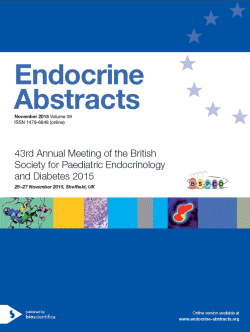
43rd Meeting of the British Society for Paediatric Endocrinology and Diabetes
e-Posters
Other
ea0039ep95 | Other | BSPED2015
Effect of dietetic management on weight in children with Bardet-Biedl syndrome
Uday Suma , Ali Muzzammil , Azam Waseema , Barrett Timothy
ea0039ep96 | Other | BSPED2015
A distinct population of islet cells defines diffuse congenital hyperinsulinism in infancy but not other forms of the disease
Han Bing Bing , Newbould Melanie , Batra Gauri , Cheesman Edmund , Craigie Ross , Mohamed Zainab , Rigby Lindsey , Padidela Raja , Skae Mars , Cosgrove Karen , Dunne Mark , Banerjee Indraneel
ea0039ep97 | Other | BSPED2015
Body surface area estimation in girls with Turner syndrome: implications for interpretation of aortic sized index
Fletcher A , McVey L , Donaldson M , Hunter L , Mason A , Wong S C
ea0039ep98 | Other | BSPED2015
Cardiovascular assessment in Turner syndrome: current practice in the UK
Mason A , Smyth A , Ahmed S F , Wong S C
ea0039ep99 | Other | BSPED2015
Positive thyroid peroxidase antibodies at diagnosis of type 1 diabetes mellitus is associated with earlier onset of thyroid disorders
Rozario Kavitha , Hlaing Su Su , Makaya Taffy
ea0039ep100 | Other | BSPED2015
Hypomagnesaemia due to lead poisoning in the context of a heterozygous CLDN-16 mutation
Ramaswamy Priya , Kurre Malathi , Muller Dominik , Dargan Paul , Gevers Evelien , Allgrove Jeremy



